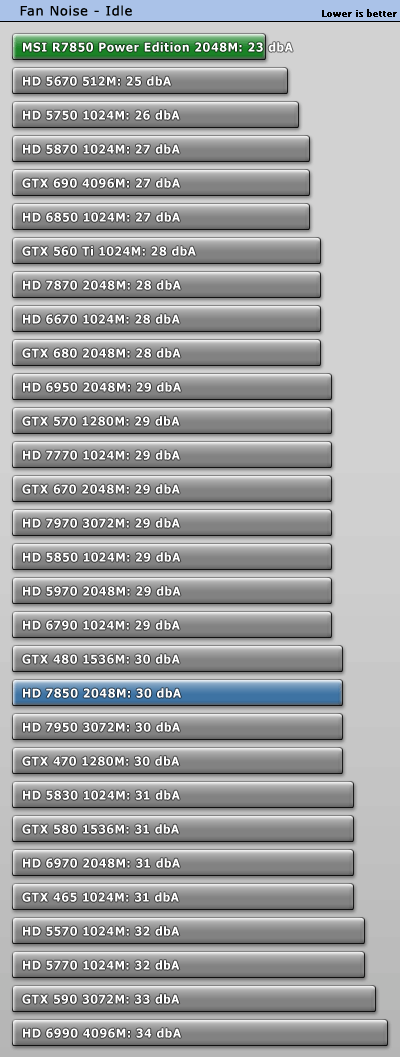 12
12
MSI R7850 Power Edition 2 GB Review
Performance Summary »Fan Noise
In the past years users would accept everything just to get more performance. Nowadays this has changed and people have become more aware of the fan noise and power consumption of their graphic cards.In order to properly test the fan noise a card emits we are using a Bruel & Kjaer 2236 sound level meter (~$4,000) which has the measurement range and accuracy we are looking for.

The tested graphics card is installed in a system that is completely passively cooled. That is passive PSU, passive CPU cooler, passive cooling on the motherboard and a solid state drive.
This setup allows us to eliminate secondary noise sources and test only the video card. To be more compliant with standards like DIN 45635 (we are not claiming to be fully DIN 45635 certified) the measurement is conducted at 100 cm distance and 160 cm over the floor. The ambient background noise level in the room is well below 20 dBA for all measurements. Please note that the dBA scale is not linear, it is logarithmic. 40 dBA is not twice as loud as 20 dBA. A 3 dBA increase results in double the sound pressure. The human hearing is a bit different and it is generally accepted that a 10 dBA increase doubles the perceived sound level. The 3D load noise levels are tested with a stressful game, not Furmark.
Idle fan noise of the R7850 Power Edition is outstanding. With 23 dbA it sits on the idle noise throne, no other card ever got lower, but others reached the same levels.
Under load the fan ramps up a lot to provide super low temperatures but the result is way too much fan noise. Ok, it is a tiny bit quieter than the AMD reference design, but that's a noisy board, too. Other AIBs do a much better job here, providing a more balanced approach to temperature and noise.


Mar 25th, 2025 13:28 EDT
change timezone
Latest GPU Drivers
New Forum Posts
- Problem with Trottlestop and HWINFO64 on MSI Raider 18 (25)
- What is going to be your next tech upgrade? just curious :) (1)
- Brand new 9950x3d crashing after a few minutes of AIDA64 CPU + FPU stress test (5)
- Black screen of death W11 (12)
- maxsun rx590* vbios (7)
- What are you playing? (23261)
- Have you got pie today? (16645)
- Milestones (14008)
- Windows 11 General Discussion (5884)
- WCG Daily Numbers (12811)
Popular Reviews
- Assassin's Creed Shadows Performance Benchmark Review - 30 GPUs Compared
- be quiet! Pure Rock Pro 3 Black Review
- ASUS ProArt X870E-Creator Wi-Fi Review
- ASRock Radeon RX 9070 XT Taichi OC Review - Excellent Cooling
- Sapphire Radeon RX 9070 XT Nitro+ Review - Beating NVIDIA
- ASUS GeForce RTX 5070 TUF OC Review
- AMD Ryzen 9 9950X3D Review - Great for Gaming and Productivity
- Quick Look: Jelly Key Mystic Snake Artisan Keycaps
- AMD Ryzen 7 9800X3D Review - The Best Gaming Processor
- XFX Radeon RX 9070 XT Mercury OC Magnetic Air Review
Controversial News Posts
- AMD RDNA 4 and Radeon RX 9070 Series Unveiled: $549 & $599 (260)
- AMD Mentions Sub-$700 Pricing for Radeon RX 9070 GPU Series, Looks Like NV Minus $50 Again (250)
- AMD Radeon RX 9070-series Pricing Leaks Courtesy of MicroCenter (158)
- MSI Doesn't Plan Radeon RX 9000 Series GPUs, Skips AMD RDNA 4 Generation Entirely (142)
- Microsoft Introduces Copilot for Gaming (123)
- AMD Radeon RX 9070 XT Reportedly Outperforms RTX 5080 Through Undervolting (118)
- NVIDIA Reportedly Prepares GeForce RTX 5060 and RTX 5060 Ti Unveil Tomorrow (115)
- Over 200,000 Sold Radeon RX 9070 and RX 9070 XT GPUs? AMD Says No Number was Given (100)
